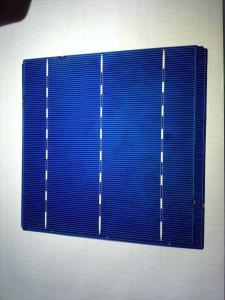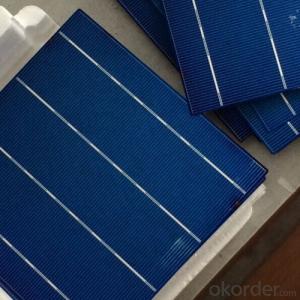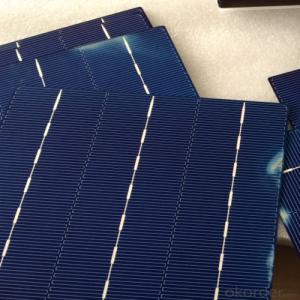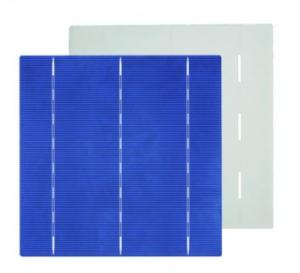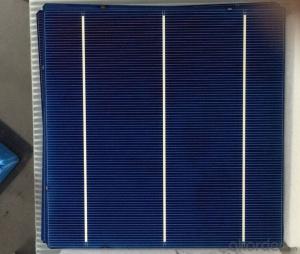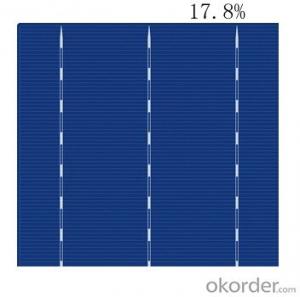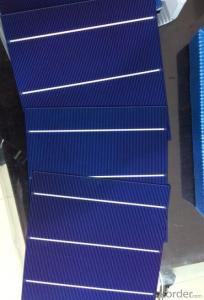Cheap Solar Cells China - Poly 3 Busbar Solar Cells Four Busbar B Grade Lower Price
- Loading Port:
- Shanghai
- Payment Terms:
- TT or LC
- Min Order Qty:
- 30000 pc
- Supply Capability:
- 3000000 pc/month
OKorder Service Pledge
OKorder Financial Service
You Might Also Like
Product description
Poly Solar Cells 156*156mm B Grade Low Price
A solar cell, or photovoltaic cell, is an electrical device that converts the energy of light directly into electricity by the photovoltaic effect, which is a physical and chemical phenomenon.[1] It is a form of photoelectric cell, defined as a device whose electrical characteristics, such as current, voltage, or resistance, vary when exposed to light. Solar cells are the building blocks of photovoltaic modules, otherwise known as solar panels.
Solar cells are described as being photovoltaic irrespective of whether the source is sunlight or an artificial light. They are used as a photodetector (for example infrared detectors), detecting light or other electromagnetic radiation near the visible range, or measuring light intensity.
In contrast, a solar thermal collector supplies heat by absorbing sunlight, for the purpose of either direct heating or indirect electrical power generation from heat. A "photoelectrolytic cell" (photoelectrochemical cell), on the other hand, refers either to a type of photovoltaic cell (like that developed by Edmond Becquerel and modern dye-sensitized solar cells), or to a device that splits water directly into hydrogen and oxygen using only solar illumination.
Advantage Of Poly Solar Cell 156mm
1: High quality cell, Level A cell (14%—17.5%)
2.Dimensione:156*156mm Diagonal:200mm
3: Qualified certification: TUV,CE certification.
4: Warranty: five years for whole unit
Usage/Application Of Poly Solar Cell 156mm
1.The absorption of light, generating either electron-hole pairs or excitons.
2.The separation of charge carriers of opposite types.
3.The separate extraction of those carriers to an external circuit.
Product Images
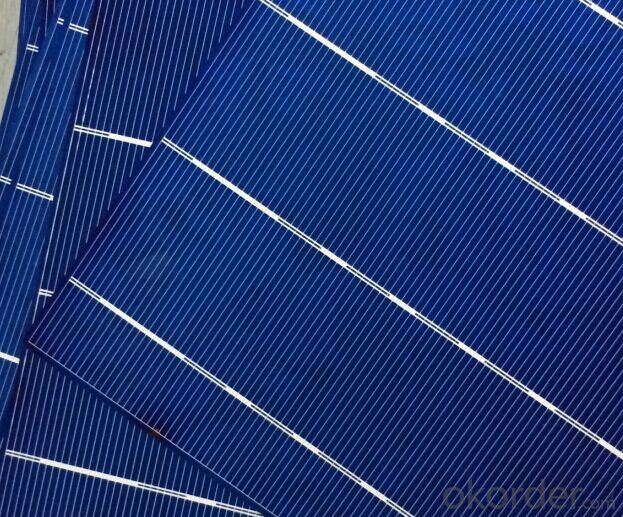

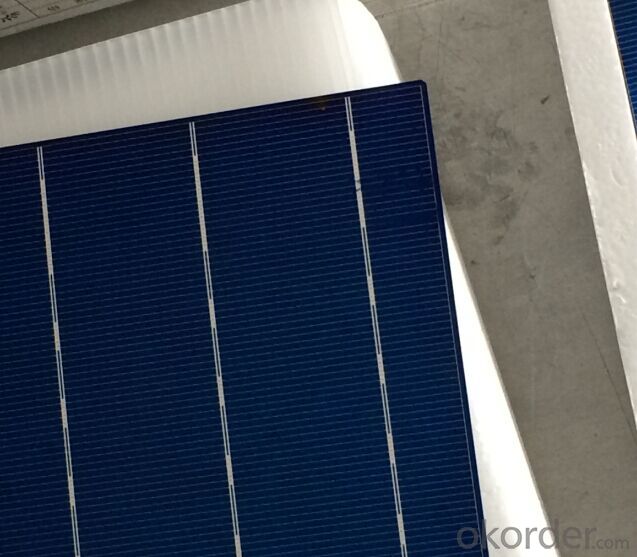
Mechanical data and design
Format | 156 mm × 156 mm ± 0.5 mm |
Thickness | 210 μm ± 40 μm |
Front(-) | 1.5mm bus bars (silver),blue anti-reflection coating (silicon nitride) |
Back (+) | 2.5 mm wide soldering pads (silver) back surface field (aluminium) |
Temperature Coefficient of Cells
Voc. Temp . coef.%/K | -0.351%/K |
Isc . Temp . coef.%/K | +0.035%/K |
Pm. Temp. coef.%/K | -0.47%/K |
Electrical Characteristic
Efficiency (%) | Pmpp (W) | Umpp (V) | Impp (A) | Uoc (V) | Isc (A) | FF (%) |
17.25 | 4.197 | 0.524 | 7.992 | 0.62 | 8.458 | 80.03% |
17 | 4.137 | 0.524 | 7.876 | 0.619 | 8.353 | 80.01% |
16.75 | 4.076 | 0.522 | 7.81 | 0.617 | 8.286 | 79.73% |
16.5 | 4.015 | 0.518 | 7.746 | 0.613 | 8.215 | 79.73 |
16.25 | 3.955 | 0.515 | 7.683 | 0.61 | 8.144 | 79.61% |
16 | 3.894 | 0.512 | 7.613 | 0.608 | 8.075 | 79.31% |
15.75 | 3.833 | 0.51 | 7.534 | 0.605 | 8.058 | 78.62% |
15.5 | 3.772 | 0.508 | 7.453 | 0.604 | 8.02 | 77.87% |
15.25 | 3.771 | 0.505 | 7.35 | 0.604 | 9.997 | 76.83% |
15 | 3.65 | 0.503 | 7.271 | 0.604 | 7.989 | 75.64% |
14.5 | 3.529 | 0.499 | 7.067 | 0.604 | 7.988 | 73.14% |
14 | 3.407 | 0.499 | 6.833 | 0.604 | 7.833 | 72.01% |
Intensity Dependence
Intensity [W/m2] | Isc× [mA] | Voc× [mV] |
1000 | 1.00 | 1.000 |
900 | 0.90 | 0.989 |
500 | 0.50 | 0.963 |
300 | 0.30 | 0.939 |
200 | 0.20 | 0.920 |
FAQ
Q:What price for each watt?
A:It depends on the quantity, delivery date and payment terms
Q:What is your warranty system?
A:Our Solar cells performance guarantees for 25 years
Q:How do you pack your products?
Brief introduction of 3 busbar solar cell
Solar cells, also known as "Solar chip" or "photovoltaic cell”, is a direct use of solar photovoltaic power generation semiconductor slice. As long as it is light that can be instantaneous output voltage and in the case of the circuit generates a current situation.
3 Busbar solar cell convert light into electrical energy through the photoelectric effect or photochemical effect directly. In the photoelectric effect of thin-film solar cells work for the mainstream, and to the implementation of the work photochemical effects of solar cells is still in its infancy.
Working principle of 3 busbar solar cell
Sun lights in the semiconductor p-n junction, forming a new hole - electron pairs in the p-n junction built-in electric field, the photo-generated holes flow to the p region, the photo-generated electrons flow into the n region, after turning circuit current. This is how the photovoltaic solar cell works.
There are two ways 3 busbar solar power working in, one is light - heat - electricity conversion mode, the other is light - electric direct conversion method.
Briefly, solar photovoltaic power generation principle is the use of solar cells to absorb 0.4μm ~ 1.1μm wavelength (for silicon) sunlight, light energy being converted into electric energy directly.
Since electricity generated by 3 busbar solar cells is DC, so if you provide electricity to all kinds of electrical appliances used in home or industrial need to install DC / AC converter, to change it into alternating current.
Most of the rechargeable solar cells apply in consumer products have charging problem. In the past general object takes charge NiMH or nickel cadmium batteries, nickel-metal hydride batteries but cannot withstand high temperatures and nickel-cadmium batteries have environmental pollution.
Super capacitor rapid development, large capacity, anti narrow area, coupled with low prices, it is part of the solar products began to shift to the super capacitor charging objects, thereby improving many of the problems of solar charging:
Charge faster,
The long life of more than 5 times,
Charging a wide temperature range,
Reduce the amount of solar cells (which can be low voltage charging).
- Q: Can solar cells be used in space heating systems?
- Yes, solar cells can be used in space heating systems. Solar cells can convert sunlight into electricity, which can then be used to power heating systems. This can be done through the use of solar thermal collectors or by converting the electricity generated by the solar cells into heat using electric heaters.
- Q: Can solar cells be used for electric vehicle charging?
- Yes, solar cells can be used for electric vehicle charging. Solar panels can convert sunlight into electricity, which can then be used to charge the batteries of electric vehicles. This allows for a sustainable and renewable source of energy for electric vehicle charging.
- Q: Can I trust the suppliers for film solar that I found on alibaba ?
- The film solar product is a mature product in the market, so most of the information of the film solar suppliers are quite transparant, which means easy to track.
- Q: Can solar cells be used for indoor applications?
- Yes, solar cells can be used for indoor applications. However, their efficiency is significantly reduced compared to outdoor use due to limited access to direct sunlight. Indoor solar cells can still generate electricity from artificial light sources, but they are typically less productive and may require additional lighting to optimize their performance.
- Q: Can solar cells be used in commercial applications?
- Yes, solar cells can be used in commercial applications. They are commonly used in various commercial sectors such as power generation, agriculture, transportation, and telecommunications. Solar panels are installed on rooftops or in open spaces to generate electricity, reducing reliance on traditional energy sources and lowering operational costs for businesses. Additionally, solar-powered street lights, solar water heaters, and solar-powered charging stations are some examples of commercial applications of solar cells.
- Q: Can solar cells be used for powering remote sensors?
- Yes, solar cells can be used to power remote sensors. Solar cells convert sunlight into electricity, making them ideal for remote locations where other power sources may be unavailable. By harnessing the sun's energy, solar cells can provide a reliable and sustainable power supply for remote sensors, ensuring their continuous operation without the need for frequent battery replacements or wired connections to the grid.
- Q: What is the payback period for solar cells?
- The payback period for solar cells depends on various factors such as the initial cost of installation, the amount of electricity generated, and the cost of traditional energy sources in the area. On average, solar cells have a payback period ranging from 5 to 10 years, but in some cases, it can be as short as 3 years or as long as 20 years.
- Q: Can solar cells be used to power water treatment plants?
- Yes, solar cells can be used to power water treatment plants. Solar energy can be harnessed to generate electricity, which can then be used to power the various processes involved in water treatment, such as pumping, filtration, and disinfection. Solar-powered water treatment plants are an environmentally friendly and sustainable solution, especially in remote areas where access to grid electricity may be limited.
- Q: Are solar cells recyclable?
- Yes, solar cells are recyclable. They contain valuable materials like silicon, glass, and metal, which can be extracted and reused. Recycling solar cells helps reduce waste and conserves resources.
- Q: Can solar cells be used for powering remote sensing devices?
- Yes, solar cells can be used to power remote sensing devices. Solar cells convert sunlight into electricity, which can then be used to power various electronic devices, including remote sensing devices. This renewable energy source is particularly advantageous for remote sensing applications as it eliminates the need for traditional power sources and allows for greater flexibility and portability in remote locations.
Send your message to us
Cheap Solar Cells China - Poly 3 Busbar Solar Cells Four Busbar B Grade Lower Price
- Loading Port:
- Shanghai
- Payment Terms:
- TT or LC
- Min Order Qty:
- 30000 pc
- Supply Capability:
- 3000000 pc/month
OKorder Service Pledge
OKorder Financial Service
Similar products
Hot products
Hot Searches
Related keywords
